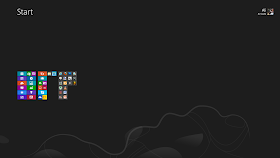Last night/very-early today at 12:01 AM Windows 8 went live for all to purchase/download; unlike windows phone 8 we've seen pretty much most of Windows 8 before in the consumer preview, but here's a look at with a fresh set of eyes in the final complete form.
I won't be reviewing Windows 8 as a whole since that's much to great of a task for a simpleton like me to conquer, but I'll try to cover the new bits (mostly UI and app changes) in several upcoming posts. This post itself is just to acquaint you with the new Metro start screen, and the new gestures available in Windows 8.
First off most people don't seem to realize that there's a lot more to Windows 8 then the new homescreen, but we'll get to that later. At first boot of windows 8 you get an option to choose your metro (or whatever we're calling it now) theme colors; an option that is surprisingly missing at first boot of windows phone devices.
Once your PC is up and running, you have the option to link your live/Hotmail/Outlook email account with your Windows 8 user account (which is a requirement to use the Windows store)- I chose to use the same account as on my Lumia, to keep things organized (contacts are automatically transferred into your people app- more on that in future posts).
Now that your PC is ready to go its time to learn the actua Windows 8 UI, I find it's easiest to visualize the actual desktop as two sides, the right and the left. Moving your cursor to either the upper or lower corners of the screen will activate the respective "sides".
- The left side of the screen acts as a task manager of sorts, wherein dragging the mouse from the upper left corner downwards will bring up a list of active/runnings programs with a thumbnail image of what the application is doing (similar to the preview seen while switching with "alt+tab").
At the bottom left corner is a shortcut that takes you between the "Metro start screen" and the last previous app you were in.
Left "side" of your PC screen
- The right "side" of the screen acts as you're settings bar for whatever application you're running (in case no applications are running it acts as a general settings bar for the whole system)- Microsoft were kind enough to call this part of the screen the "Charms bar". Below is an example of the general desktop settings that can be controlled from the charms bar, the lower half of the Settings menu acts as a notification center and a replacement toolbar, from which you can control your WiFi, battery, Volume, Brightness, Language etc.
- In the bottom left corner of the Metro start menu is a tiny "minimize button" when clicked the whole start menu zooms out giving you a wider view of your desktop; very useful once you have a large number of apps installed.

- Metro designed applications can be asymmetrically "snapped" to either side of the screen, allowing for side by side multitasking; such as playing music in the smaller window while browsing, or having the messenger app open while working on a project.



- Besides the task switcher built into the left side of the screen you can still use the trusty old "alt+tab" method to navigate between your open application (using Windows key + tab will switch through the applications on the task switcher pane on the left side of the screen).

- Screenshots can automatically be taken and saved in Windows 8 without the need of opening Paint and pasting your screen capture into a new file, simply pressing Windows key + Prt Sc. will save the screen capture in your default images library inside a folder called "Screenshots"
Alternatively you can press "Windows Key + S" to select a specific part of the screen you'd like to capture, rather than the whole screen. - Pressing "Windows Key + C" in any application/folder will bring up the Charms Bar as well as the system time & general notification (battery, Wifi, date).

- Dragging any Metro designed app from the top of the screen all the way down will automatically close the app (equivalent of Alt + F4 which by the way still works).

.png)


No comments:
Post a Comment